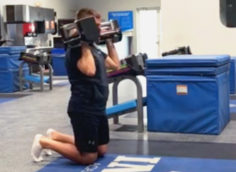The rectus femoris, the big muscle belly that ties the vastus lateralis and the vastus medialis together, doesn't grow much with squats. Why? Because it's a two-jointed muscle. It crosses both the hip joint and the knee joint and works as a flexor of the hip as well as an extensor of the knee.
So when you squat down, the rectus femoris gets longer at the knee end, and shortens at the hip end. This means that it pretty much maintains its length and doesn't contract a whole lot.
EMG-studies have shown that while the vastus muscles contract at a factor 100 during the squat, the rectus only contracts at a factor 50. Confused? Don't worry. Just know that a low level of contraction equals less growth.
Research backs this up. One such study from Fonseca et al. had a bunch of participants do a whole range of quad exercises (squats, lunges, leg presses and deadlifts), and a different bunch do squats. While the multi-exercise participants achieved growth in all four parts of the quads, the squat-participants consistently lacked growth in the rectus femoris.
In another study, 8 weeks of squatting resulted in significant growth of the vasti (plural for both vastus) muscles, but no growth was seen in the rectus femoris.
Researchers studied rowers and road racing cyclists and found little growth of their rectus femoris as well. Think about that. Rowing and bike riding require the same biomechanics as the squat – simultaneous knee and hip flexion, which evidently results in sparse rectus activity.

The single-joint movements, like the leg extension.
In one study (Ema et al), researchers put this theory to the test, and found that leg extensions resulted in more growth of the rectus femoris (26%) than the vastus medialis (12%), the vastus intermedius (6%) and the vastus lateralis (11%) after 12 weeks of training.
In addition, a couple of older studies showed that the squat was more efficient than leg extensions in terms of activation of the vastus lateralis and vastus medialis, but as for the rectus femoris, leg extensions were definitely superior.
- Fonseca RM et al. Changes in exercises are more effective than in loading schemes to improve muscle strength. J Strength Cond Res. 2014 Nov;28(11):3085-92. PubMed.
- Ema R et al. Unique muscularity in cyclists' thigh and trunk: A cross-sectional and longitudinal study. Scand J Med Sci Sports. 2016 Jul;26(7):782-93. PubMed.
- Ema R et al. Inferior muscularity of the rectus femoris to vasti in varsity oarsmen. Int J Sports Med. 2014 Apr;35(4):293-7. PubMed.
- Ema R et al. Inhomogeneous architectural changes of the quadriceps femoris induced by resistance training. Eur J Appl Physiol. 2013 Nov;113(11):2691-703. PubMed.
- Fonseca RM et al. Changes in exercises are more effective than in loading schemes to improve muscle strength. J Strength Cond Res. 2014 Nov;28(11):3085-92. PubMed.





